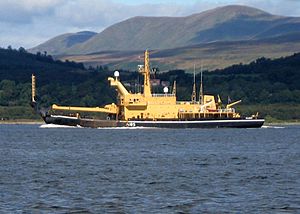RMAS Salmoor (A185) facts for kids

RMAS Salmoor on the Firth of Clyde, 2006
|
|
Quick facts for kids History |
|
|---|---|
| Name | RMAS Salmoor (A185) |
| Ordered | 31 September 1984 |
| Builder | Hall, Russell & Company |
| Laid down | 10 January 1985 |
| Launched | 25 May 1985 |
| Commissioned | 10 September 1985 |
| Out of service | 2008 |
| Homeport | HMNB Clyde |
| Status | Transferred to Serco Marine Services |
| Name | SD Salmoor |
| In service | 2008 |
| Out of service | 2013 |
| Homeport | HMNB Clyde |
| Identification |
|
| Status | Retired |
| General characteristics | |
| Class and type | Sal-class large lifting ships |
| Displacement | 2,200 tonnes |
| Length | 77 m |
| Beam | 15 m |
| Draught | 4 m |
| Propulsion | 2 diesels, 1 shaft, 4,000 bhp |
| Speed | 15 knots (28 km/h; 17 mph) |
| Complement | 19 |
The SD Salmoor was a special kind of ship that helped keep things safe in the water. It was known as a mooring and salvage vessel. This means it helped set up and look after important underwater equipment, like anchors for other ships or special targets for training. It could also help rescue things from the water if they got lost or damaged.
The Salmoor worked near HMNB Clyde, which is a big naval base in Scotland. Its home was at Great Harbour in Greenock.
This ship was built in 1985 by a company called Hall, Russell & Company. It was quite a large ship, weighing about 2,200 tonnes. It was 77 meters long (that's about the length of 7 school buses!), 15 meters wide, and went 4 meters deep into the water. The Salmoor had a crew of 19 people and could travel at a speed of 15 knots (about 28 kilometers per hour).
Contents
What the Salmoor Did
The Salmoor had several important jobs. These jobs were all about making sure things worked smoothly and safely in the water.
Setting Up Underwater Equipment
One of its main tasks was to lay and maintain underwater targets. These targets were used by the navy for training exercises. The ship also helped place and look after navigation marks. These are like road signs for ships, helping them know where to go and where to avoid.
Maintaining Moorings
The Salmoor was also responsible for moorings. Moorings are like giant anchors that keep ships or other floating structures in one place. The Salmoor made sure these moorings were strong and in the right spot.
Who Operated the Ship?
The Salmoor had two different operators during its time in service.
Royal Maritime Auxiliary Service
When it was first built, the Salmoor was operated by the Royal Maritime Auxiliary Service (RMAS). This was a special organization that supported the Royal Navy by providing various services, including operating ships like the Salmoor. Its full name then was RMAS Salmoor (A185).
Serco Marine Services
In March 2008, the Royal Maritime Auxiliary Service was closed down. The Salmoor then started to be operated by a company called Serco Marine Services. It continued its important work under this new operator until it was retired in 2013.
Ship Details
The Salmoor was part of a group of ships called the Sal-Class large lifting ships. They were designed to be strong and capable for their specific tasks.
Size and Power
The ship's large size allowed it to carry heavy equipment needed for its jobs. It was powered by two diesel engines, which gave it a total of 4,000 horsepower. This power was sent to one propeller shaft, allowing the ship to move through the water.
Crew and Speed
With a crew of 19, the ship could operate efficiently. Its top speed of 15 knots was good for getting to different locations to perform its duties.
See also
- Naval Service (United Kingdom)
- List of ships of Serco Marine Services

